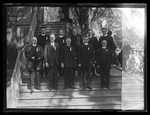Keywords: Franco-American Collection
- Historical Items (291)
- Tax Records (0)
- Architecture & Landscape (0)
- Online Exhibits (16)
- Site Pages (7)
- My Maine Stories (1)
- Lesson Plans (0)
Online Exhibits
Your results include these online exhibits. You also can view all of the site's exhibits, view a timeline of selected events in Maine History, and learn how to create your own exhibit. See featured exhibits or create your own exhibit
Exhibit
From French Canadians to Franco-Americans
French Canadians who emigrated to the Lewiston-Auburn area faced discrimination as children and adults -- such as living in "Little Canada" tenements and being ridiculed for speaking French -- but also adapted to their new lives and sustained many cultural traditions.
Exhibit
In the early 1600s, French explorers and colonizers in the New World quickly adopted a Native American mode of transportation to get around during the harsh winter months: the snowshoe. Most Northern societies had some form of snowshoe, but the Native Americans turned it into a highly functional item. French settlers named snowshoes "raquettes" because they resembled the tennis racket then in use.
Exhibit
Immigration is one of the most debated topics in Maine. Controversy aside, immigration is also America's oldest tradition, and along with religious tolerance, what our nation was built upon. Since the first people--the Wabanaki--permitted Europeans to settle in the land now known as Maine, we have been a state of immigrants.
Exhibit
Music in Maine - Community and School Marching Bands
"… Alphonse Cote, Lewiston, 1918Franco-American Collection, University of Southern Maine Libraries Click to explore Franco Marching Bands…"
Exhibit
"Bruns’ collection of instruments and songbooks, Elise Fellows White, violin prodigy Elise Fellows White, Skowhegan, ca."
Exhibit
St-Jean-Baptiste Day -- June 24th -- in Lewiston-Auburn was a very public display of ethnic pride for nearly a century. Since about 1830, French Canadians had used St. John the Baptist's birthdate as a demonstration of French-Canadian nationalism.
Exhibit
Rum, Riot, and Reform - Reform and Repeal
"1920 Collections of Maine Historical Society/Maine Today Media Coll. 1949; 2005.061.13657 These temperate citizens on a parade review stand in…"
Exhibit
Lewiston, Maine's second largest city, was long looked upon by many as a mill town with grimy smoke stacks, crowded tenements, low-paying jobs, sleazy clubs and little by way of refinement, except for Bates College. Yet, a noted Québec historian, Robert Rumilly, described it as "the French Athens of New England."
Exhibit
Like many cities in France, Lewiston and Auburn's skylines are dominated by a cathedral-like structure, St. Peter and Paul Church. Now designated a basilica by the Vatican, it stands as a symbol of French Catholic contributions to the State of Maine.
Exhibit
The Barns of the St. John River Valley: Maine's Crowning Jewels
Maine's St. John River Valley boasts a unique architectural landscape. A number of historical factors led to the proliferation of a local architectural style, the Madawaska twin barn, as well as a number of building techniques rarely seen elsewhere. Today, these are in danger of being lost to time.
Exhibit
Fallen Heroes: Maine's Jewish Sailors and Soldiers
Thirty-four young Jewish men from Maine died in the service of their country in the two World Wars. This project, including a Maine Memory Network exhibit, is meant to say a little something about some of them. More than just names on a public memorial marker or grave stone, these men were getting started in adult life. They had newly acquired high school and college diplomas, they had friends, families and communities who loved and valued them, and felt the losses of their deaths.
Exhibit
Graduations -- and schools -- in the 19th through the first decade of the 20th century often were small affairs and sometimes featured student presentations that demonstrated what they had learned. They were not necessarily held in May or June, what later became the standard "end of the school year."
Exhibit
World War I and the Maine Experience
With a long history of patriotism and service, Maine experienced the war in a truly distinct way. Its individual experiences tell the story of not only what it means to be an American, but what it means to be from Maine during the war to end all wars.
Exhibit
Port of Portland's Custom House and Collectors of Customs
The collector of Portland was the key to federal patronage in Maine, though other ports and towns had collectors. Through the 19th century, the revenue was the major source of Federal Government income. As in Colonial times, the person appointed to head the custom House in Casco Bay was almost always a leading community figure, or a well-connected political personage.
Exhibit
The history of the region now known as Maine did not begin at statehood in 1820. What was Maine before it was a state? How did Maine separate from Massachusetts? How has the Maine we experience today been shaped by thousands of years of history?
Exhibit
Begin Again: reckoning with intolerance in Maine
BEGIN AGAIN explores Maine's historic role, going back 528 years, in crisis that brought about the pandemic, social and economic inequities, and the Black Lives Matter movement in 2020.
















